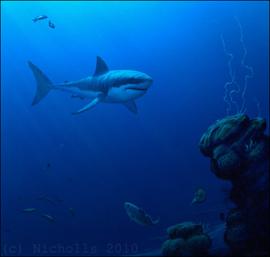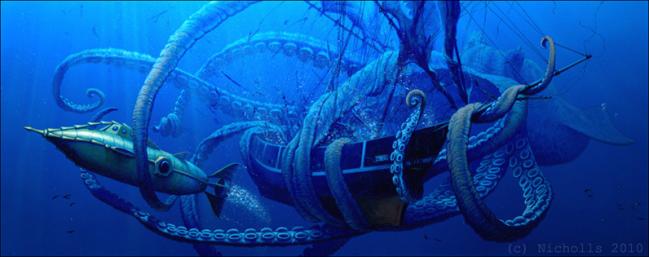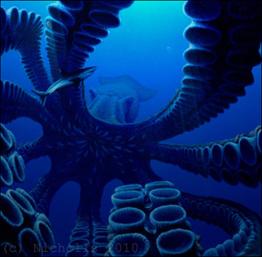 Paintings
Paintings

 Cenozoic
Cenozoic

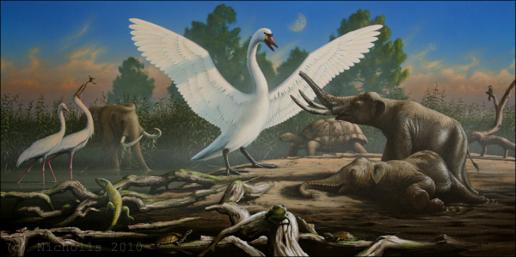
Of Giants and Dwarfs
Courtesy of Michael Gatt
As the sun rises and begins to warm the fresh morning air, a variety of extinct and extant Maltase animals congregate at a waterhole. They include two Elephas falconeri, an Elephas mnaidriensis, Leithia melitensis, Geochelone robusta, Emys orbicularis, Lacerta siculamelitensis, Bufo bufo & Bufo viridis, Discoglossus pictus, Grus melitensis, and the giant flightless swan, Cygnus falconeri.
As the sun rises and begins to warm the fresh morning air, a variety of extinct and extant Maltase animals congregate at a waterhole. They include two Elephas falconeri, an Elephas mnaidriensis, Leithia melitensis, Geochelone robusta, Emys orbicularis, Lacerta siculamelitensis, Bufo bufo & Bufo viridis, Discoglossus pictus, Grus melitensis, and the giant flightless swan, Cygnus falconeri.
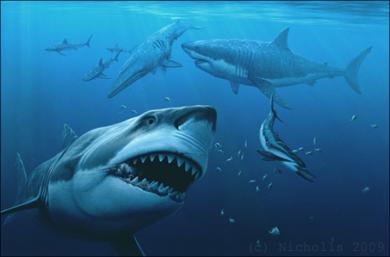
Mega Tooth Rising
Courtesy of Michael Gatt
The Miocene oceans were dangerous places to swim. Even the great baleen whales, such as Cetotherium, could fall victim to toothed physteroids and, of course, Carcharocles megalodon. Known to many simply as, megalodon, this 16m long predator possessed the size and strength to kill and eat the largest creatures on Earth.
The Miocene oceans were dangerous places to swim. Even the great baleen whales, such as Cetotherium, could fall victim to toothed physteroids and, of course, Carcharocles megalodon. Known to many simply as, megalodon, this 16m long predator possessed the size and strength to kill and eat the largest creatures on Earth.

Harvest Dawn
Kingfisher Publishing
At dawn 9,000 years ago, on the Fertile Crescent a settlement of early farmers are at work. In the foreground a man is using a flint sickle to harvest wild wheat while on the other side of a basic fence a woman and a girl are carrying water. Below the buildings, on the other side of an irrigation channel is a herd of domesticated sheep and goats. Beyond them more farmers harvest the fields of wheat.
At dawn 9,000 years ago, on the Fertile Crescent a settlement of early farmers are at work. In the foreground a man is using a flint sickle to harvest wild wheat while on the other side of a basic fence a woman and a girl are carrying water. Below the buildings, on the other side of an irrigation channel is a herd of domesticated sheep and goats. Beyond them more farmers harvest the fields of wheat.
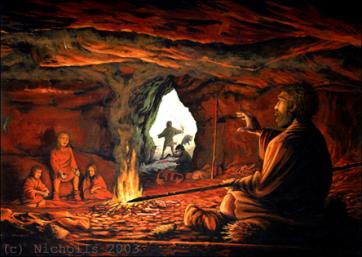
The Story Teller
Creswell Crags Visitor Centre
50,000 years ago, a family of Homo neanderthalensis made a home inside ‘Robin Hood’s Cave, in Creswell Gorge. Two children sit at the feet of their mother, who is napping flint, while their father tells a great tail about hunting giant reindeer.
50,000 years ago, a family of Homo neanderthalensis made a home inside ‘Robin Hood’s Cave, in Creswell Gorge. Two children sit at the feet of their mother, who is napping flint, while their father tells a great tail about hunting giant reindeer.
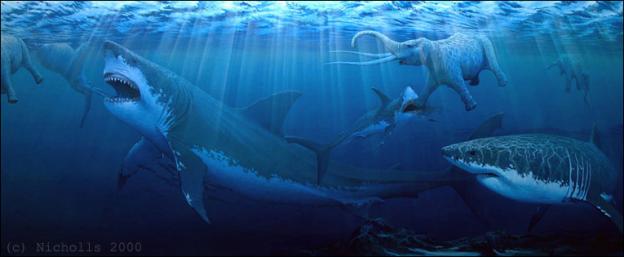
Devourer of Giants
Private commission
A herd of Anancus (mastodons) have drowned in a flash flood and now their dead and bloated bodies drift with the current in a shallow ocean. Soon, their odour attracts two adult and one juvenile Charcarocles megalodon. These colossal sharks grew to fifty tonnes in weight, and therefore megalodon is a contender for the title of Earth’s supreme predator.
A herd of Anancus (mastodons) have drowned in a flash flood and now their dead and bloated bodies drift with the current in a shallow ocean. Soon, their odour attracts two adult and one juvenile Charcarocles megalodon. These colossal sharks grew to fifty tonnes in weight, and therefore megalodon is a contender for the title of Earth’s supreme predator.
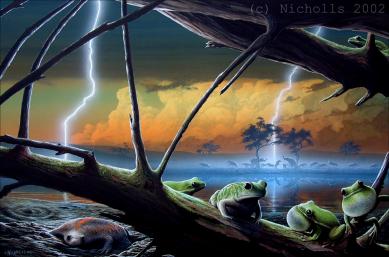
Electric Miocene
Indiana University Press
North America during the Miocene (23 to 5.3 million year ago). This is the cover artwork for Fossil Frogs and Toads of North America, by the late and great J. Alan Holman.
North America during the Miocene (23 to 5.3 million year ago). This is the cover artwork for Fossil Frogs and Toads of North America, by the late and great J. Alan Holman.
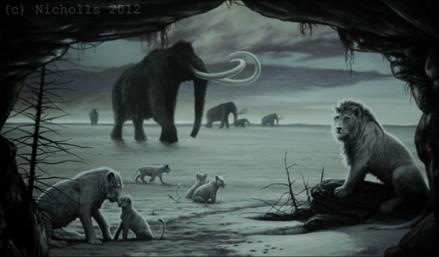
Lion Cave
Courtesy of Karen Miller
The view across the tundra from inside ‘Lion Cave’ (Ice Age Britain) is sometimes barren and bleak but today we can see old and new life. As the name suggests this cave is home to a pair of cave lions (Panthera leo spelaea) and their young cubs.
The view across the tundra from inside ‘Lion Cave’ (Ice Age Britain) is sometimes barren and bleak but today we can see old and new life. As the name suggests this cave is home to a pair of cave lions (Panthera leo spelaea) and their young cubs.
 Mesozoic
Mesozoic

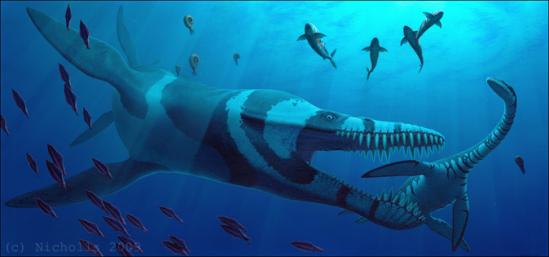
Leviathan
Museum of Jurassic Marine Life
The greatest predators in the Jurassic oceans were pliosaurs, some of which grew over 12m in length. Here an enormous Pliosaurus lunges forward to capture and swallow a Cryptoclidus whole. Above this attack are four large fish, called Pachycormus, and below swim ammonites, Pectinates, and a shoal of belemnites, Belemnoteuthis.
The greatest predators in the Jurassic oceans were pliosaurs, some of which grew over 12m in length. Here an enormous Pliosaurus lunges forward to capture and swallow a Cryptoclidus whole. Above this attack are four large fish, called Pachycormus, and below swim ammonites, Pectinates, and a shoal of belemnites, Belemnoteuthis.

Bait Ball
Museum of Jurassic Marine Life
In a desperate attempt to avoid capture thousands of Thrissops fish swarm together into a bait ball. Trachyteuthis belemnites and Pectinatites ammonites also take action to leave the scene as three ichthyosaurs (unnamed) hunt for prey. The youngest ichthyosaur darts into the bait ball causing the Thrissops to separate and open a writhing circular window to the ocean surface above.
In a desperate attempt to avoid capture thousands of Thrissops fish swarm together into a bait ball. Trachyteuthis belemnites and Pectinatites ammonites also take action to leave the scene as three ichthyosaurs (unnamed) hunt for prey. The youngest ichthyosaur darts into the bait ball causing the Thrissops to separate and open a writhing circular window to the ocean surface above.
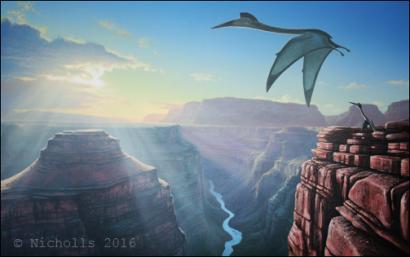
The Launch
Private commission
A juvenile looks on as a great adult, with a 10m wingspan, launches from a cliff top above a speculative canyon landscape.
A juvenile
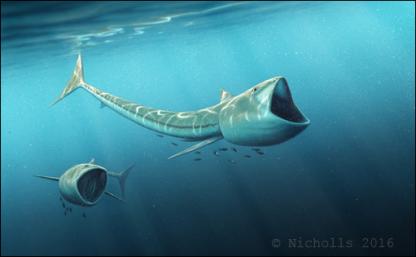
Tube Fish
Schumacher et al
Two slender Rhinconichthys uyenoi swim gracefully through a Cretaceous ocean. These beautiful filter feeding fish grew up to 4.5m long.
Two slender Rhinconichthys uyenoi swim gracefully through a Cretaceous ocean. These beautiful filter feeding fish grew up to 4.5m long.
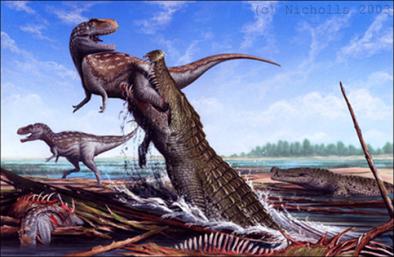
Reaper in Paradise
Private commission
Deinosuchus means 'terror crocodile' and it is a well deserved name because Deinosuchus riograndensis was a dinosaur eater! Its enormously powerful jaws and killing death roll were capable of tearing apart even large dinosaurs. But before consuming its prey, Deinosuchus may have wedged dead animals under submerged rocks and vegetation to slowly decay.
Deinosuchus means 'terror crocodile' and it is a well deserved name because Deinosuchus riograndensis was a dinosaur eater! Its enormously powerful jaws and killing death roll were capable of tearing apart even large dinosaurs. But before consuming its prey, Deinosuchus may have wedged dead animals under submerged rocks and vegetation to slowly decay.
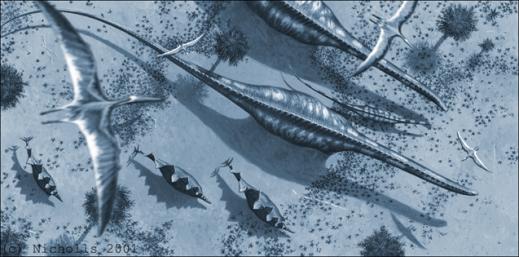
Above the Prairie
Orpheus Books
Seen from above, this is an environment that would eventually become known, by some Holocene apes, as the ‘Morrison Formation’. Amongst swooping pterosaur shadows wander migrating stegosaurs and magnificent diplodocids.
Seen from above, this is an environment that would eventually become known, by some Holocene apes, as the ‘Morrison Formation’. Amongst swooping pterosaur shadows wander migrating stegosaurs and magnificent diplodocids.
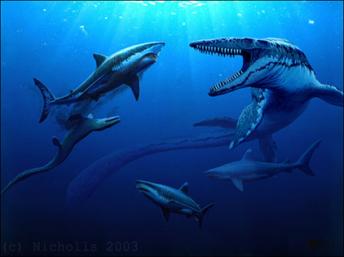
Cretaceous Jaws
Private commission
Late in the Cretaceous period a giant shark, Cretoxyrhina mantelli, feasts upon a juvenile Tylosaurus prorigor. Two other large sharks, Squalicorax kaupi, move in and await an opportunity to steal a bite from the sinking carcass. All three sharks must feed quickly before the smell of blood attracts more sharks, or worse, an adult tylosasaur!
Late in the Cretaceous period a giant shark, Cretoxyrhina mantelli, feasts upon a juvenile Tylosaurus prorigor. Two other large sharks, Squalicorax kaupi, move in and await an opportunity to steal a bite from the sinking carcass. All three sharks must feed quickly before the smell of blood attracts more sharks, or worse, an adult tylosasaur!
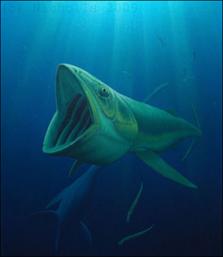
Filter Feeding
Oxford University Natural History Museum
Through the blue depths of a shallow ocean calmly swims a 6m long fish, called Bonnerichthys. With its jaws agape the Bonnerichthys continuously filters krill and other organic matter from the water to fuel its huge body. Smaller fish are vulnerable to many marine hunters but a fully grown Bonnerichthys is large enough to avoid attack from all but the biggest predators.
Through the blue depths of a shallow ocean calmly swims a 6m long fish, called Bonnerichthys. With its jaws agape the Bonnerichthys continuously filters krill and other organic matter from the water to fuel its huge body. Smaller fish are vulnerable to many marine hunters but a fully grown Bonnerichthys is large enough to avoid attack from all but the biggest predators.
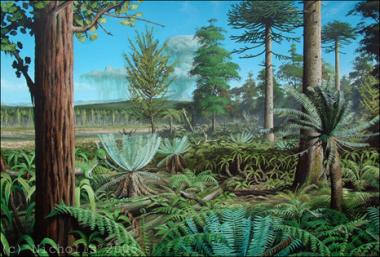
Alexander Island
British Antarctic Survey
If you were standing on Alexander Island (the largest island of Antarctica) during the Cretaceous, this is what you may have seen. There is one dinosaur in this picture but its green skin means it is camouflaged beautifully amongst the thick foliage. The vegetation includes Gingko trees, Monkey Puzzle trees, Taeiopteris, Aculea, Phyllopteroides, and a variety of cycads, ferns, tree ferns, and horsetails.
If you were standing on Alexander Island (the largest island of Antarctica) during the Cretaceous, this is what you may have seen. There is one dinosaur in this picture but its green skin means it is camouflaged beautifully amongst the thick foliage. The vegetation includes Gingko trees, Monkey Puzzle trees, Taeiopteris, Aculea, Phyllopteroides, and a variety of cycads, ferns, tree ferns, and horsetails.
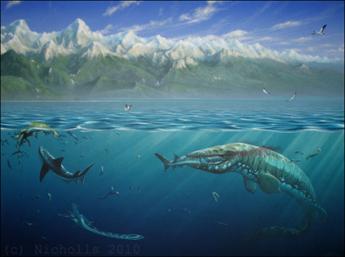
Life Before the Freezer
British Antarctic Survey
If you were 50km off the cost of the Antarctic Peninsula (60 degrees west of the Prime Meridian) during the Cretaceous, this is what you may have seen. Fossil discoveries prove that below the snow capped mountains and the tree covered foothills was an unfrozen ocean, teeming with fish, marine reptiles and even the occasional dead and rotting dinosaur.
If you were 50km off the cost of the Antarctic Peninsula (60 degrees west of the Prime Meridian) during the Cretaceous, this is what you may have seen. Fossil discoveries prove that below the snow capped mountains and the tree covered foothills was an unfrozen ocean, teeming with fish, marine reptiles and even the occasional dead and rotting dinosaur.
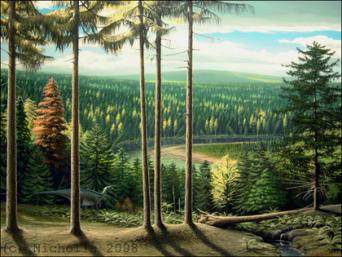
Big Cretaceous
British Antarctic Survey
Antarctica during the Cretaceous was a very different place to what it is today. From a hilltop overlooking a river we can see it is a green environment comprised of Larches, Sitka Spruce, Norway Spruce, Bald Cypress, Yew, and Gingko trees. There are also Juniper bushes, ferns, cycads, horsetails, and lichens.
Antarctica during the Cretaceous was a very different place to what it is today. From a hilltop overlooking a river we can see it is a green environment comprised of Larches, Sitka Spruce, Norway Spruce, Bald Cypress, Yew, and Gingko trees. There are also Juniper bushes, ferns, cycads, horsetails, and lichens.
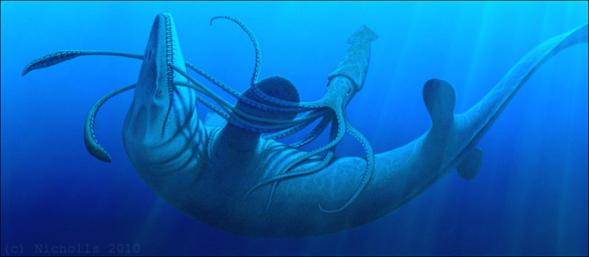
Mosasaurus at Play
GeoCenter Møns Klint
Mosasaurs were the undisputed heavyweight champions of the Cretaceous oceans. The largest species, such as Mosasaurus hoffmanni, reached lengths of about 15m and they had skulls as big as Tyrannosaurus rex. Giant squids (Architeuthis is our modern species) are formidable creatures but they may have been playthings to a fully grown mosasaur.
Mosasaurs were the undisputed heavyweight champions of the Cretaceous oceans. The largest species, such as Mosasaurus hoffmanni, reached lengths of about 15m and they had skulls as big as Tyrannosaurus rex. Giant squids (Architeuthis is our modern species) are formidable creatures but they may have been playthings to a fully grown mosasaur.
 Palaeozoic
Palaeozoic

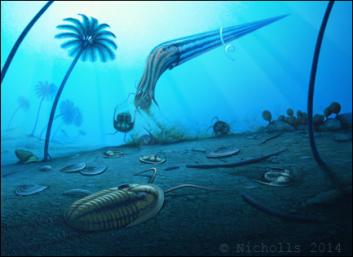
Trilobite Dingle
Powysland Museum
A scene from the Welshpool district during the Ordovician Period. Featured are crinoids, an othrocone, graptolite, a gastropod, “othid” and strophomenid brachiopods, Salterolithus and Parabasilicus trilobites.
A scene from the Welshpool district during the Ordovician Period. Featured are crinoids, an othrocone, graptolite, a gastropod, “othid” and strophomenid brachiopods, Salterolithus and Parabasilicus trilobites.

Symbiotic Invertebrates
Natural History Museum, London
Here we see the worm-like animal Inquicus fellatus, infesting Cricocosmia jinningensis, a marine worm that lived on and in the ocean sediments 520 million years ago. This is one of the earliest examples of a symbiotic relationship between invertebrates; the fossil was found in China.
Here we see the worm-like animal Inquicus fellatus, infesting Cricocosmia jinningensis, a marine worm that lived on and in the ocean sediments 520 million years ago. This is one of the earliest examples of a symbiotic relationship between invertebrates; the fossil was found in China.
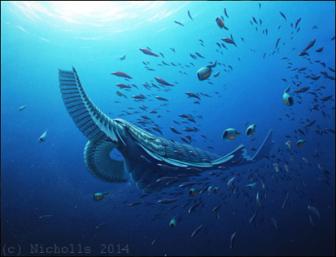
Gentle Giant
Courtesy of Jakob Vinther
A 70cm long Tamisiocaris borealis glides through the ocean sweeping up mesozooplankton with its facial appendages. The gentle giant is accompanied by a variety of other Cambrian invertebrates, including the early chordate, Myllokunmingia, the enigmatic vetulicolian, Ooedigera, and the bivalve arthropod, Isoxys.
A 70cm long Tamisiocaris borealis glides through the ocean sweeping up mesozooplankton with its facial appendages. The gentle giant is accompanied by a variety of other Cambrian invertebrates, including the early chordate, Myllokunmingia, the enigmatic vetulicolian, Ooedigera, and the bivalve arthropod, Isoxys.

Melee for the Dead
Kingfisher Publishing
The stench of a rotting Eogyrinus corpse attracts invertebrates of all shapes and sizes from a dark Carboniferous forest. Amongst them are a 3m long millipede-like Arthropleura, the giant dragonfly Meganeura, and a huge Hibbertopterus ‘sea-scorpion.’ A colourful adult male Ophiacodon then enters the scene and stakes his claim to the maggot infested carrion.
The stench of a rotting Eogyrinus corpse attracts invertebrates of all shapes and sizes from a dark Carboniferous forest. Amongst them are a 3m long millipede-like Arthropleura, the giant dragonfly Meganeura, and a huge Hibbertopterus ‘sea-scorpion.’ A colourful adult male Ophiacodon then enters the scene and stakes his claim to the maggot infested carrion.
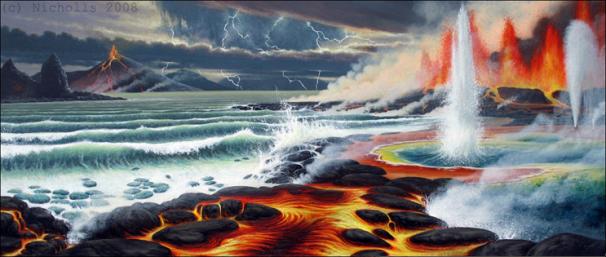
The Achaean
Roar Publishing
The Achaean was a geological eon spanning from 2500 million years ago to 4000 million years ago. The air during this time lacked free oxygen but life, in the form of cyanobacterial mats (Prokaryota), was widespread in water. Hot springs, erosion, lightening strikes, ocean tides, active tectonics, and many other factors made the Achaean an exciting period in Earth history.
The Achaean was a geological eon spanning from 2500 million years ago to 4000 million years ago. The air during this time lacked free oxygen but life, in the form of cyanobacterial mats (Prokaryota), was widespread in water. Hot springs, erosion, lightening strikes, ocean tides, active tectonics, and many other factors made the Achaean an exciting period in Earth history.
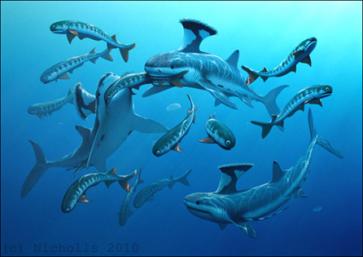
The Three Ugly Brothers
Courtesy of Matt Dale
For some unseen reason, a shoal of Acanthodes act nervously while they swim through gin blue Carboniferous waters. Then, as if from nowhere, three male Akmonistion sharks swoop in from all directions and attack. The Acanthodes are smaller and more agile but one is caught and rapidly consumed.
For some unseen reason, a shoal of Acanthodes act nervously while they swim through gin blue Carboniferous waters. Then, as if from nowhere, three male Akmonistion sharks swoop in from all directions and attack. The Acanthodes are smaller and more agile but one is caught and rapidly consumed.
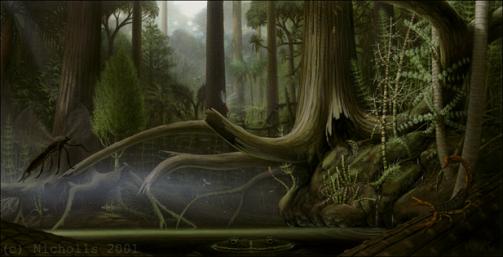
Green Pond
Courtesy of Alistair Bowden
The air above Green Pond was warm, moist and contained a high concentration of oxygen (35%, compared to 21% today). A multitude of invertebrates, some of which were giants, immersed the dense vegetation with a cacophony of calls and fluttering wings. While below, within the Green Pond’s surface tension, predatory eyes await a meal.
The air above Green Pond was warm, moist and contained a high concentration of oxygen (35%, compared to 21% today). A multitude of invertebrates, some of which were giants, immersed the dense vegetation with a cacophony of calls and fluttering wings. While below, within the Green Pond’s surface tension, predatory eyes await a meal.
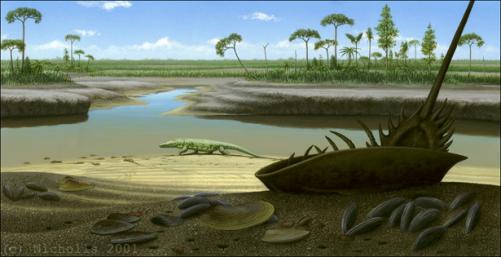
Horseshoe River
Courtesy of Alistair Bowden
Horseshoe River meandered slowly through a low Carboniferous wetland. On the outside of a bend the deep alluvium is slowly but relentlessly undercut by the gentle current and the green landscape constantly changes. Inside the bend are the remains of those creatures that inhabit Horseshoe River and some living horseshoe crabs flee from an approaching temnospondyl.
Horseshoe River meandered slowly through a low Carboniferous wetland. On the outside of a bend the deep alluvium is slowly but relentlessly undercut by the gentle current and the green landscape constantly changes. Inside the bend are the remains of those creatures that inhabit Horseshoe River and some living horseshoe crabs flee from an approaching temnospondyl.
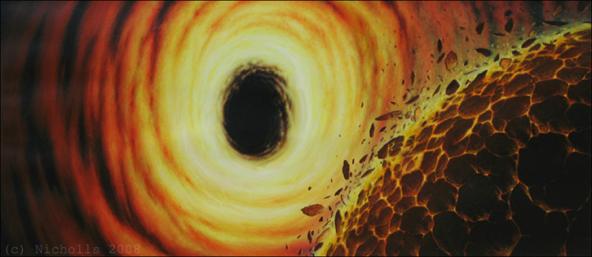
Black Hole
Roar Publishing
Sometime in the distant past far away, a planet is destroyed by a black hole. The black hole’s enormous gravitational forces stretch and squeeze the orbiting planet until it glows red hot and starts to disintegrate. The planet’s crust fractures, breaks apart and is sucked through space towards the irresistible black abyss.
Sometime in the distant past far away, a planet is destroyed by a black hole. The black hole’s enormous gravitational forces stretch and squeeze the orbiting planet until it glows red hot and starts to disintegrate. The planet’s crust fractures, breaks apart and is sucked through space towards the irresistible black abyss.
 Fiction
Fiction



